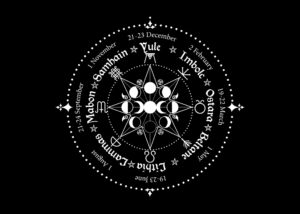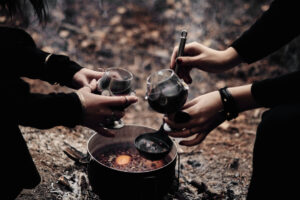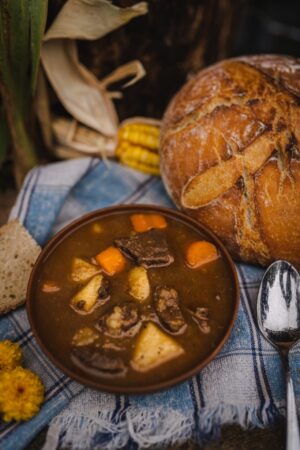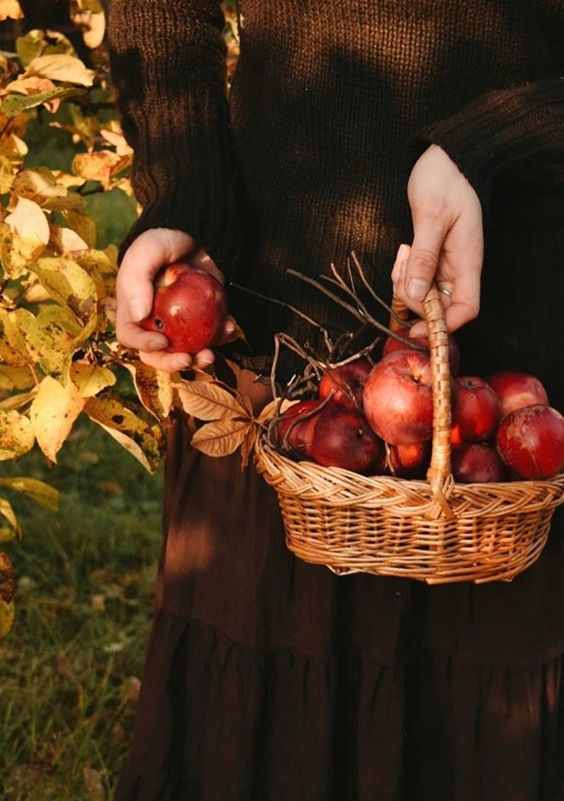I find the celebration of Mabon to be one of the most significant events of the year. Mabon is a festival that marks the autumn equinox and is often celebrated on or around September 21st. It is a time of balance, where day and night are equal, and we give thanks for the abundance of the harvest season. Mabon rituals are primarily centered around balance, so this is a great time to rebalance yourself and look back on your year.
Mabon is a time for reflection and gratitude, and many Pagans choose to celebrate this festival with rituals and ceremonies. These rituals often involve the lighting of candles, the burning of incense, and the offering of food and drink to the gods and goddesses.
Some people choose to hold their rituals in nature, such as in a forest or by a river, while others prefer to celebrate in their homes or at a local Pagan community center. Regardless of the location, the focus is on honoring the changing of the seasons and the cycles of life and death.
In this blog post, I’m going to cover every aspect of Mabon, from popular Mabon rituals (including a full-on ritual for serious practitioners) to the history, culture, symbolism, and deities associated with Mabon. Let’s dive in!
Understanding Mabon

Mabon is a pagan holiday that is celebrated on the Autumnal Equinox, which usually falls on September 21st or 22nd. This holiday is also known as the Second Harvest, and it marks the end of the harvest season.
As a pagan, I believe that Mabon is a time to give thanks for the abundance of the harvest and to prepare for the coming winter. It is a time to reflect on the balance between light and dark, and to honor the changing of the seasons.
During Mabon, many pagans perform rituals and ceremonies to celebrate the holiday. These rituals often involve the use of symbols, such as apples, pumpkins, and corn. They may also include the lighting of candles, the burning of incense, and the casting of spells.
One of the most important aspects of Mabon is the concept of balance. This holiday marks the time when the day and night are equal in length, and it is a time to reflect on the balance between light and dark in our lives.
In conclusion, Mabon is a holiday that celebrates the changing of the seasons and the abundance of the harvest. It is a time to reflect on balance and to give thanks for all that we have. As a pagan, I look forward to celebrating Mabon each year and honoring the cycles of nature.
History of Mabon Rituals
Mabon is a pagan holiday that celebrates the autumn equinox, which occurs around September 21st. It is a time to give thanks for the harvest and to prepare for the coming winter. Mabon rituals have been practiced by pagans for centuries and have evolved over time.
The origins of Mabon rituals can be traced back to ancient Celtic traditions. The Celts celebrated a festival called Samhain, which marked the end of the harvest season and the beginning of winter. Samhain was a time when the veil between the world of the living and the dead was believed to be thinnest, and it was a time to honor ancestors and seek guidance from the spirit world.
As Christianity spread throughout Europe, many pagan traditions were absorbed into Christian holidays. Samhain became All Saints’ Day, and many of the rituals associated with Samhain were incorporated into Halloween.
In the 20th century, interest in paganism and witchcraft grew, and Mabon became an important holiday for many modern pagans. Today, Mabon rituals vary widely depending on the tradition and the individual practitioner. Some common elements of Mabon rituals include:
- Giving thanks for the harvest
- Honoring ancestors and the spirit world
- Lighting candles and making offerings of food or drink
- Holding a feast or potluck
- Performing divination or other forms of spiritual work
Overall, Mabon is a time to reflect on the changing seasons and to connect with the natural world. Whether you are a seasoned practitioner or a curious beginner, there are many ways to celebrate Mabon and to honor the traditions of our ancestors.
Significance of Mabon Rituals
Mabon is a time of balance, when day and night are equal, and we prepare for the coming darkness of winter. As I explore Mabon rituals, I have come to understand their significance in celebrating this time of year.
Mabon rituals are a way to honor the harvest and give thanks for the abundance of the season. They provide an opportunity to reflect on the blessings in our lives and express gratitude for all that we have received.
These rituals also help us to connect with nature and the cycles of the earth. By acknowledging the changing of the seasons, we can better understand our place in the world and our relationship with the natural world.
Through Mabon rituals, we can also focus on balance and harmony in our lives. By recognizing the equal balance of light and dark, we can strive for balance within ourselves and our relationships with others.
In summary, Mabon rituals are a meaningful way to celebrate the changing of the seasons, express gratitude, and seek balance in our lives.
The Symbolism of Mabon
This ancient pagan holiday, also known as the Autumn Equinox, is steeped in symbolism that reflects the cyclical nature of life, the bounty of the harvest, and the delicate balance between light and dark. Join us on a journey of discovery as we delve into the rich tapestry of symbolism that makes Mabon a cherished and meaningful celebration.
Harvest Abundance: At the heart of Mabon lies a celebration of the bountiful harvest, a time when communities would gather the fruits of their labor from the fields. The symbolism of abundance is palpable, as farmers and gatherers rejoiced in the culmination of their hard work throughout the growing season. Fields brimming with ripe grains, plump vegetables, and juicy fruits evoke a sense of gratitude for the Earth’s generosity and the sustenance it provides. Mabon encourages us to honor the cycle of planting, nurturing, and reaping, reminding us of the interconnectedness between nature and our own lives.
Balance and Equilibrium: Mabon falls on the day when daylight and darkness are perfectly balanced, ushering in the autumnal equinox. This delicate equilibrium mirrors the universal dance of opposites—life and death, light and shadow, expansion and contraction. As the sun sets earlier each day, we are reminded of the need for balance in our own lives. Mabon encourages us to reflect on the dualities within ourselves and the world around us, inspiring us to find harmony amidst the contrasting forces that shape our existence.
Transition and Reflection: Just as the Earth undergoes a gradual transformation during autumn, shedding its lush greenery for a tapestry of reds, oranges, and golds, Mabon serves as a time of personal reflection and transition. The changing landscape serves as a mirror for our own inner processes, urging us to release what no longer serves us and embrace the wisdom of change. Symbolically, Mabon invites us to pause and assess our journey, to acknowledge our growth, and to prepare for the introspective season ahead.
Apples, Gourds, and Leaves: A tapestry of natural symbols adorns the Mabon celebration. Apples, often associated with wisdom and abundance, are not only harvested during this time but also serve as a reminder of the cyclical nature of life and death. Gourds and pumpkins, with their robust and protective exteriors, symbolize the nurturing aspect of the Earth and the shelter it provides. The falling leaves, ablaze with color before gently descending, embody the beauty of impermanence and the art of letting go.
Feasting and Sharing: Central to Mabon celebrations is the act of feasting and sharing. The communal breaking of bread highlights the interconnectedness of individuals within a community and underscores the importance of gratitude and generosity. Sharing a meal with loved ones emphasizes the significance of coming together to celebrate life’s blessings, fostering a sense of unity and collective appreciation.
Mabon Ritual Ideas:

Here are some general Mabon rituals typically practiced on this pagan holiday.
Harvest Feast: Prepare a feast using locally harvested and seasonal foods. Share this meal with friends and family to celebrate the abundance of the season.
Nature Walk or Hike: Take a walk in nature to appreciate the changing colors of the leaves and the beauty of the season. Collect fallen leaves, acorns, or other natural items to use in your rituals.
Altar Setup: Create a Mabon altar with symbols of the season, such as apples, pumpkins, gourds, grains, and autumn leaves. Place candles in autumn colors like orange, red, and brown.
Candle Magic: Light candles in colors associated with Mabon and set intentions for balance and gratitude. You could also use this time to reflect on your achievements and set goals for the coming season.
Gratitude Ritual: Write down things you are grateful for on individual pieces of paper. Place these papers in a jar or under a candle on your altar. This can serve as a reminder of the blessings in your life.
Wine or Apple Cider Blessing: Raise a glass of wine or apple cider and offer a toast to the changing seasons. You can also pour a small amount of the beverage onto the Earth as an offering.
Hearth and Home Blessing: Clean and cleanse your living space, then smudge with sage or perform a ritual house cleaning to welcome the new season and remove stagnant energy.
Tarot or Oracle Readings: Use divination tools to gain insights into the energies of the upcoming season or to reflect on your personal journey.
Crafting and DIY: Create crafts that symbolize the season, such as wreaths, sachets, or decorations made from natural materials.
Feasting and Sharing: Invite friends and family over for a potluck or a meal where everyone brings a dish made from seasonal ingredients. Share stories, traditions, and celebrate together.
Druidic Rituals: If you follow a Druidic path, you might consider performing rituals that honor the spirits of the land, the changing of the seasons, and the deities associated with harvest and nature.
Remember, Mabon is a time of balance and reflection. Feel free to adapt these rituals to your own spiritual beliefs and practices, and make them meaningful to you.
Mabon Recipes and Foods:

One of my favorite things about Mabon is the variety of foods that are traditionally associated with the holiday. From apples and pumpkins to root vegetables and grains, there are endless possibilities for creating delicious and nourishing meals. Whether you’re planning a feast for family and friends or simply looking for some new recipe ideas, there are plenty of Mabon-inspired dishes to explore.
Breads and Grains
I love baking bread for Mabon. The smell of fresh bread is so comforting and adds to the cozy atmosphere of the holiday. Here are a few traditional Mabon bread and grain recipes:
- Cornbread: Cornbread is a classic Mabon dish that can be served as a side or as a main dish. I like to add some diced jalapenos for a little kick.
- Apple and Oat Bread: This bread is perfect for breakfast or as a snack. It’s hearty and filling, and the combination of apples and oats is delicious.
- Wild Rice Pilaf: Wild rice is a staple grain for Mabon. This pilaf is easy to make and pairs well with roasted vegetables or meats.
Fruits and Vegetables
Mabon is a celebration of the harvest, so it’s no surprise that fruits and vegetables take center stage. Here are a few traditional Mabon recipes that highlight the bounty of the season:
- Roasted Vegetables: Roasting vegetables brings out their natural sweetness and makes them extra delicious. I like to roast a mix of root vegetables, like carrots, potatoes, and parsnips.
- Apple and Cranberry Sauce: This sauce is a great alternative to traditional cranberry sauce. The combination of apples and cranberries is sweet and tart, and it pairs well with turkey or pork.
- Pumpkin Soup: Pumpkin soup is a classic Mabon dish. It’s warm and comforting, and the addition of spices like cinnamon and nutmeg make it extra flavorful.
Meats and Poultry
Meats and poultry are often served at Mabon feasts. Here are a few traditional Mabon recipes that feature these proteins:
- Roast Turkey: Roast turkey is a classic Mabon dish. It’s hearty and filling, and pairs well with roasted vegetables and mashed potatoes.
- Braised Pork: Braised pork is a great alternative to turkey. It’s tender and flavorful, and the addition of apples or cranberries makes it extra delicious.
- Venison Stew: Venison stew is a hearty and warming dish that’s perfect for a cool autumn evening. The addition of root vegetables like carrots and potatoes make it extra filling.
Desserts
No feast is complete without dessert. Here are a few traditional Mabon desserts:
- Apple Pie: Apple pie is a classic Mabon dessert. The combination of sweet and tart apples, cinnamon, and nutmeg is perfect for the season.
- Pumpkin Pie: Pumpkin pie is another classic Mabon dessert. It’s warm and comforting, and the addition of spices like cinnamon and nutmeg make it extra delicious.
- Pear and Ginger Crisp: This crisp is a great alternative to pie. The combination of pears and ginger is sweet and spicy, and the topping of oats and brown sugar is crunchy and delicious.
Drinks for Mabon
Non-Alcoholic Beverages
As much as I love to indulge in a good alcoholic beverage, sometimes it’s nice to have a non-alcoholic option, especially if you’re celebrating with children or those who don’t drink. Here are a few ideas for non-alcoholic beverages to serve during your Mabon celebration:
- Spiced Apple Cider: This classic fall beverage is perfect for Mabon. Heat up apple cider on the stove with cinnamon sticks, cloves, and allspice berries for a warm and cozy drink.
- Cranberry Sparkler: Mix cranberry juice with sparkling water and a squeeze of lime for a refreshing and festive drink. Add a sprig of rosemary or a few cranberries for garnish.
- Pumpkin Spice Latte: For a cozy and indulgent treat, make your own pumpkin spice latte at home. Combine hot coffee with pumpkin puree, pumpkin pie spice, and milk of your choice. Top with whipped cream and a sprinkle of cinnamon.
Alcoholic Beverages
If you’re looking for something a little stronger to celebrate Mabon, there are plenty of delicious alcoholic beverages to choose from. Here are a few ideas:
- Mulled Wine: Warm up red wine on the stove with cinnamon sticks, cloves, and orange slices for a spiced and cozy drink. Add a splash of brandy for extra warmth.
- Hard Cider: If you’re a fan of beer, try switching it up with hard cider. There are plenty of seasonal options available during the fall months.
- Apple Cider Margarita: For a festive twist on a classic cocktail, combine tequila, apple cider, lime juice, and a splash of triple sec. Rim the glass with cinnamon sugar for extra flavor.
No matter what you choose to drink during your Mabon celebration, make sure to enjoy it with good company and in the spirit of the season.
Mabon Food Traditions and Symbolism
Mabon is a time of harvest and abundance, and as such, many of the foods and recipes associated with this holiday are rich, hearty, and filling. As someone who loves to cook and celebrate the changing seasons, I always look forward to the traditional foods of Mabon.
One of the most important symbols of Mabon is the apple, which represents the bounty of the harvest and the cycle of life and death. Apples are often used in Mabon recipes, such as apple pies, apple cider, and apple butter. Other fruits and vegetables that are commonly associated with Mabon include pumpkins, squash, and grapes.
In addition to fruits and vegetables, grains and breads are also an important part of Mabon food traditions. Bread represents the sustenance of life, and grains such as wheat and barley symbolize the fertility of the earth. Many Mabon recipes incorporate these ingredients, such as hearty breads, grain salads, and soups.
Finally, meat and game are often served during Mabon, as they represent the hunt and the cycle of life and death. Venison, rabbit, and other game meats are popular choices for Mabon feasts, as are hearty stews and casseroles made with beef or pork.
Overall, the foods and recipes associated with Mabon are rich in symbolism and meaning, and they reflect the importance of the harvest and the changing seasons. As someone who loves to cook and celebrate the changing of the seasons, I always look forward to the traditional foods of Mabon, and I enjoy exploring new recipes and flavors each year.
Deities of Mabon

While most deities have a balance aspect that can be associated with Mabon, these are the deities you’ll see most often involved in pagan Mabon rituals:
Modron
Modron is a Welsh goddess who is often associated with motherhood and nurturing. She is sometimes referred to as “the Great Mother” and is believed to have given birth to Mabon ap Modron, who is also associated with the autumnal equinox. In some stories, Modron is also associated with the harvest and is said to have provided food and sustenance for her people.
Mabon ap Modron
Mabon ap Modron is the son of Modron and is often considered to be a god of youth and rebirth. He is associated with the harvest and is said to have been taken from his mother at a young age, only to be rescued later by the hero Culhwch. Mabon is sometimes referred to as “the Divine Youth” and is believed to have been born at the autumnal equinox.
Morgan le Fay
Morgan le Fay is a figure from Arthurian legend who is often associated with magic and the supernatural. While she is not strictly a Celtic deity, she is sometimes included in lists of deities associated with Mabon due to her association with the autumnal equinox. In some stories, Morgan is said to have been a powerful sorceress who used her magic to aid King Arthur and his knights.
Pomona
Pomona was a Roman goddess of fruit trees, gardens, and orchards. She was often depicted holding a cornucopia or a pruning knife. Her name comes from the Latin word “pomum,” which means “fruit.” Pomona’s influence can be seen in Mabon through the celebration of the harvest and the abundance of fruit during this time. The apple, which is often associated with Pomona, is also a symbol of Mabon.
Vertumnus
Vertumnus was a Roman god of gardens, orchards, and seasons. He was often depicted with a cornucopia or a basket of fruit. His name comes from the Latin word “vertere,” which means “to change.” Vertumnus’s influence can be seen in Mabon through the changing of the seasons and the celebration of the harvest. The cornucopia, which is often associated with Vertumnus, is also a symbol of Mabon.
Persephone
I find it fascinating how the Greek goddess Persephone has influenced some of the deities celebrated during the Mabon season. Persephone is known as the queen of the underworld and the goddess of spring growth. Her story of being abducted by Hades and then returning to the world above has been interpreted in different ways by different cultures.
During Mabon, some pagans celebrate the return of Persephone from the underworld as a symbol of the return of light and life after the darkness of winter. Others see her as a representation of the balance between light and dark, life and death, and the cyclical nature of existence.
Learn more about working with Persephone here.
Demeter
Another Greek goddess that has influenced Mabon deities is Demeter, the goddess of agriculture, fertility, and the harvest. Demeter is often associated with the cycle of life and death, as well as the changing of the seasons.
During Mabon, some pagans honor Demeter as a symbol of the abundance of the harvest and the gratitude for the Earth’s bounty. Her story of searching for her daughter Persephone in the underworld is also seen as a metaphor for the descent into darkness and the eventual return to the light.
Learn more about working with Demeter here.
Freyr
Freyr is a Norse deity associated with fertility, prosperity, and peace. He is often depicted as a handsome man with golden hair and a beard, wearing a cloak and carrying a magical sword. Freyr is also known as the lord of the elves and the ruler of Alfheim, the land of the elves.
In Mabon, Freyr is worshipped as a god of harvest and abundance. He is believed to bless the crops and ensure a bountiful harvest. His association with fertility also makes him a popular deity among couples trying to conceive.
Freyja
Freyja is a Norse goddess associated with love, fertility, war, and death. She is often depicted as a beautiful woman wearing a necklace of amber and carrying a magical staff. Freyja is also known as the leader of the Valkyries, female warriors who choose who will die in battle and who will live.
In Mabon, Freyja is worshipped as a goddess of love and fertility. She is believed to bless couples with children and protect them from harm. Her association with war and death also makes her a powerful deity for those seeking protection in battle.
Learn more about working with Freya here.
Cernunnos:
This Celtic god of the hunt and fertility is often associated with the changing of the seasons and the cycles of life and death. He is often depicted with antlers and is seen as a protector of the wild places.
These are the deities most commonly found in pagan Mabon rituals. However, you can work with just about any deity. I recommend working with fall harvest deities around this time of year, since you’ll see many of the same things (death and rebirth, transition, and reflection). You can also work with deities of death and the underworld as again, many of the themes will be similar.
How To Perform A Full Mabon Ritual:
Looking to do a full-on Mabon ritual? Here are the elements of a Mabon ritual and how it typically proceeds.
Setting the Altar
To begin preparing for a Mabon ritual, I start by setting up my altar. I choose a location that is quiet and free from distractions. I then cover the altar with a cloth in autumnal colors, such as orange, brown, or gold.
Next, I add items that represent the season and the harvest. I may include things like pumpkins, gourds, acorns, or leaves. I also add candles in warm colors, such as red, orange, or yellow. These candles represent the warmth and light of the harvest season.
Choosing Symbols
Choosing symbols for the Mabon ritual is an important part of the preparation. I choose symbols that represent the harvest and the balance between light and dark. Some common symbols include:
- Cornucopia: symbolizes abundance and the harvest
- Apples: represent the fruit of the harvest
- Grapes: represent the wine of the harvest
- Sunflowers: symbolize the sun and the harvest
- Leaves: represent the changing of the seasons
I choose symbols that have personal meaning to me and that will help me connect with the energy of the season.
Preparing the Feast
The feast is an important part of the Mabon ritual. I prepare a meal that includes foods that are in season, such as apples, squash, and pumpkin. I also include foods that represent the harvest, such as bread and wine.
I set the table with autumnal colors and decorations, such as leaves or small pumpkins. I light candles to create a warm and inviting atmosphere.
Preparing the feast is a time to connect with the energy of the season and to share in the abundance of the harvest with friends and family.
Casting the Circle
To begin the Mabon ritual, I first cast a circle. This is done by walking around the perimeter of the ritual space, often with a wand or athame, and visualizing a protective barrier forming around the area. I call upon the elements of earth, air, fire, and water to be present within the circle, and ask for their guidance and protection during the ritual.
Invoking the Deities
Once the circle is cast, I invoke the deities that I wish to work with during the ritual. For Mabon, I often call upon deities associated with the harvest and the changing of the seasons, such as Demeter, Persephone, or Ceres. I also invite any ancestors or spirits that I wish to honor and work with during the ritual.
Offering Gratitude
After invoking the deities, I take time to offer gratitude for the blessings in my life. This can be done through meditation, prayer, or by physically offering gifts to the deities or spirits. I often offer fruits, vegetables, or other items that are associated with the harvest and the abundance of the season.
Feasting and Sharing
Finally, I conclude the ritual by sharing a feast with those who have participated in the ceremony. This is a time to celebrate the blessings of the season and to come together in community. I often prepare foods that are associated with the harvest, such as roasted vegetables or apple cider.
Overall, performing Mabon rituals is a powerful way to connect with the changing of the seasons and to honor the cycles of nature. By casting a circle, invoking the deities, offering gratitude, and sharing in a feast, I am able to tap into the energy of the season and to connect with the divine.
Thanking the Deities
As the Mabon ritual comes to a close, it is important to thank the deities that were called upon during the ceremony. I thank the God and Goddess for their presence and guidance throughout the ritual. I acknowledge their power and their willingness to assist me in my spiritual journey.
Closing the Circle
After thanking the deities, it is time to close the circle. I walk around the circle clockwise, beginning in the North, and say a brief thank you to each direction. I use a feather or a wand to symbolically close the circle by drawing an imaginary line in the air.
Once the circle is closed, I take a moment to ground myself and reflect on the ritual. I may choose to meditate or journal about my experiences. It is important to take time to integrate the energy of the ritual before returning to everyday life.
Overall, closing the Mabon ritual is an important part of the ceremony. It allows me to express gratitude to the deities and to return to a grounded state of being.
Customizing Your Mabon Rituals
As someone who has been practicing Mabon rituals for years, I’ve found that the most meaningful and powerful rituals are the ones that are customized to my personal beliefs and preferences. Here are some tips for customizing your own Mabon ritual:
1. Choose a Theme
One way to customize your Mabon ritual is to choose a theme that resonates with you. For example, you could focus on gratitude, balance, or letting go. Once you have chosen a theme, you can incorporate it into your ritual through your altar decorations, the types of offerings you make, and the words you speak during the ritual.
2. Personalize Your Altar
Your altar is the centerpiece of your Mabon ritual, and it’s a great place to showcase your personal style and beliefs. Consider incorporating items that are meaningful to you, such as crystals, statues, or symbols of your spiritual path. You can also add seasonal items like leaves, acorns, or pumpkins to create a festive atmosphere.
3. Choose Your Offerings
Offerings are a key part of any Mabon ritual, and they can be customized to suit your personal preferences. Some common offerings include fruits, vegetables, wine, or baked goods. You can also choose offerings that are specific to your chosen theme, such as offering up things you are grateful for or releasing things that no longer serve you.
4. Create Your Ritual Script
Your ritual script is the backbone of your Mabon ritual, and it’s important to create one that feels authentic to you. Consider including elements like invocations, prayers, or affirmations that reflect your personal beliefs and intentions. You can also include activities like meditation, journaling, or dancing to make the ritual feel more personal and meaningful.
Remember, the most important thing when customizing your Mabon ritual is to stay true to yourself and your beliefs. By incorporating your own personal touches, you can create a ritual that is powerful, meaningful, and uniquely yours.
Mabon in Different Cultures:
FAQs About Celebrating Mabon:
What are some traditional ways to celebrate Mabon?
Some traditional ways to celebrate Mabon include making offerings to the gods and goddesses, holding a feast with friends and family, going apple picking or pumpkin picking, and decorating your home with autumnal colors and symbols.
What are some symbols associated with Mabon?
Some symbols associated with Mabon include the harvest moon, cornucopias, apples, pumpkins, acorns, and leaves changing color.
Is Mabon only celebrated by pagans?
Typically, Mabon is a pagan holiday and is primarily celebrated by those who practice pagan or neopagan religions.
Can I celebrate Mabon if I’m not pagan?
Absolutely! Mabon’s themes of balance, gratitude, and connection with nature can resonate with people from various spiritual backgrounds. You can adapt the celebrations to your beliefs and create meaningful rituals or activities to mark the season.
How is Mabon different from other fall holidays like Halloween or Thanksgiving?
Mabon is a pagan holiday that celebrates the autumnal equinox and the harvest season, while Halloween has roots in the Celtic festival of Samhain and is associated with death and the supernatural. Thanksgiving is a secular holiday celebrated in the United States and Canada that focuses on giving thanks for the blessings of the year and sharing a meal with loved ones.
Can I celebrate Mabon on my own?
Yes, Mabon can be celebrated individually or in small groups. Many rituals and activities can be adapted for personal practice, allowing you to connect with the energies of the season and embrace the themes of Mabon in a way that feels meaningful to you.
What are some books I can read to learn more about Mabon?
There are many books available that can help you learn more about Mabon and its traditions. Here are a few:
“Mabon: Rituals, Recipes & Lore for the Autumn Equinox” by Diana Rajchel: This book provides a comprehensive guide to Mabon, including its history, rituals, and traditional foods.
“Witch’s Wheel of the Year: Rituals for Circles, Solitaries & Covens” by Jason Mankey: This comprehensive pagan book teaches you how to celebrate holidays in a way truly rooted in history.
“The Witch’s Book of Shadows: The Craft, Lore & Magick of the Witch’s Grimoire” by Phyllis Curott: This book includes a section on Mabon, as well as other pagan holidays and rituals.
“The Sabbats: A New Approach to Living the Old Ways” by Edain McCoy: This book provides an overview of the eight Sabbats, including Mabon, and offers suggestions for incorporating them into your spiritual practice.
“The Modern Witchcraft Spell Book: Your Complete Guide to Crafting and Casting Spells” by Skye Alexander: While not specifically focused on Mabon, this book includes many spells and rituals that can be adapted for use during the autumnal equinox.
“The Celtic Spirit: Daily Meditations for the Turning Year” by Caitlín Matthews: This book provides daily meditations and reflections for each of the eight Celtic festivals, including Mabon.
How does Mabon relate to other pagan holidays?
Mabon is one of the eight Sabbats in the Wheel of the Year, which includes other pagan holidays like Samhain, Yule, Imbolc, Ostara, Beltane, Litha, and Lammas. These holidays collectively mark the changing seasons and cycles of nature.
How far back does Mabon go?
The origins of Mabon are not entirely clear, as it is a modern pagan holiday that was created in the mid-20th century. However, it is based on ancient Celtic and Welsh harvest festivals, which were celebrated around the time of the autumnal equinox. These festivals honored the gods and goddesses of the harvest and marked the end of the summer growing season. The name “Mabon” comes from a Welsh mythological figure who was said to have been born on the autumnal equinox and later rescued from the underworld. While the exact history of Mabon is difficult to trace, it is rooted in ancient traditions and has been adapted for modern pagan and nature-based spiritual practices.
Why should I celebrate Mabon?
Whether or not you should celebrate Mabon depends on your personal beliefs and values. If you are interested in pagan or nature-based spiritual traditions, Mabon can be a meaningful way to honor the changing of the seasons and connect with the natural world. It can also be a time to reflect on the past year, give thanks for the abundance of the harvest, and find balance in your life. Even if you do not follow a specific spiritual path, you may still find value in celebrating Mabon as a way to connect with nature and the cycles of life. Ultimately, the decision to celebrate Mabon is up to you and what feels meaningful and authentic to your own beliefs and practices.
Can I celebrate Mabon even if I don’t believe in deities?
Yes, you can celebrate Mabon even if you do not believe in deities. While Mabon has roots in pagan and nature-based spiritual traditions that often involve the worship of gods and goddesses, it can also be celebrated in a secular or non-theistic way. For example, you may choose to focus on the themes of gratitude, balance, and reflection, and incorporate practices such as feasting, nature walks, and crafts into your celebration. You may also choose to view Mabon as a time to connect with the natural world and honor the cycles of life, without necessarily attributing these cycles to a specific deity or spiritual force. Ultimately, the way you choose to celebrate Mabon is up to you and what feels authentic and meaningful to your own beliefs and values.
Mabon is a time of balance, reflection, and gratitude for the abundance of the harvest. Whether you follow a specific spiritual path or simply appreciate the beauty of nature, there are many ways to celebrate this autumnal equinox festival.
From feasting on seasonal foods to performing rituals and ceremonies, there are many Mabon rituals that can help you connect with the natural world and find balance in your life.
Whether you choose to celebrate alone or with friends and family, take the time to reflect on the past year and give thanks for all that you have. By honoring the cycles of life and the changing of the seasons, you can find peace, joy, and a deeper connection to the world around you.


